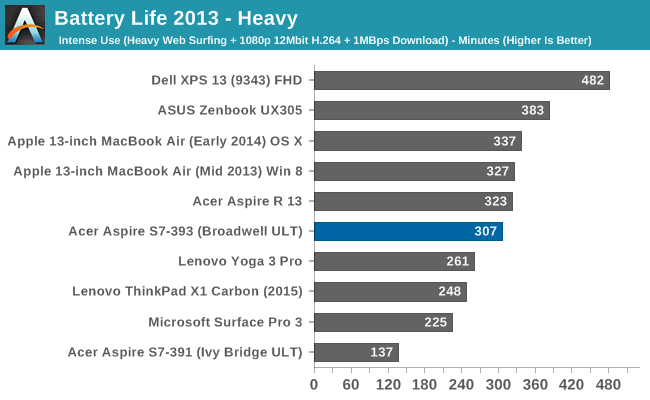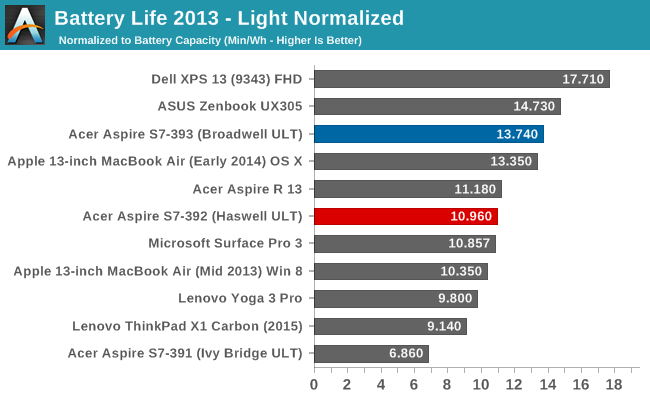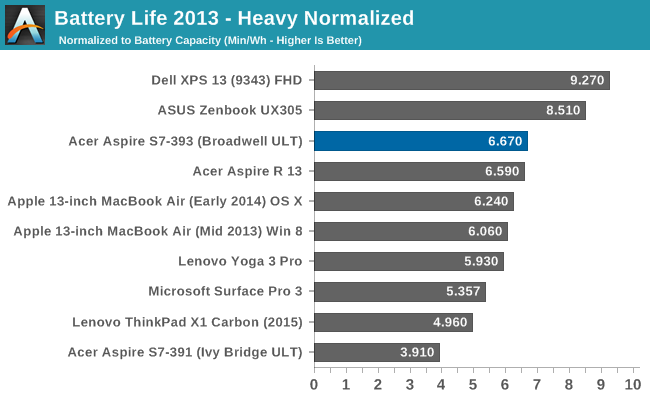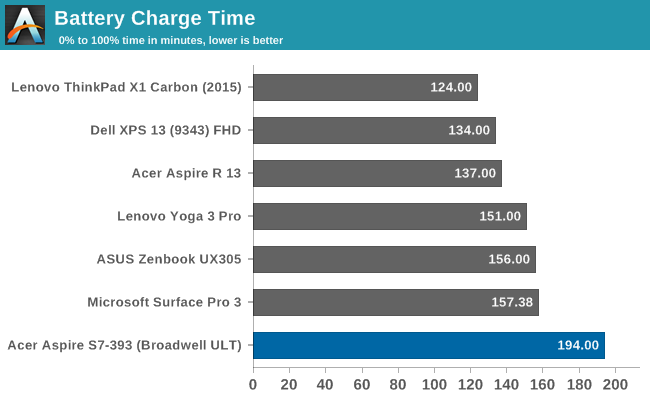The Acer Aspire S7-393 Review: Broadwell Comes To Acer's Ultrabook
by Brett Howse on October 5, 2015 8:00 AM ESTBattery Life and Charge Time
Broadwell brought a lot of nice changes over Haswell. The move to 14 nm transistors from the 22 nm of Haswell brought about lower operating voltages, which results in less power being dissipated. This of course means better battery life too. The CPU is only a small part of the overall power output of a notebook, especially at light workloads where most of the CPU can be power gated. The display is a big percentage of the overall power drain on light workloads, and other factors come into play too like the wireless card and even the SSD – or both SSDs in this case.
Something pretty remarkable is that Acer has sampled us nearly identical Aspire S7 models for the past three generations. That means that we have battery life results on an almost identical notebook going back to Ivy Bridge. All three S7 models all came with the same resolution display too. There may be some changes to backlight efficiency, but overall we can look at a single notebook and see how much more power efficient it has gotten in three generations which is pretty neat.
All tests are done with the default browser (now Edge) and the display set at 200 nits.
Light Battery

The light test consists of light web browsing with the display set at 200 nits. It is heavily influenced by the display, especially in 2015 where the processors are so power efficient at idle or close to it. The Aspire S7 does very well in this test coming in very close to the Core M powered UX305 from ASUS. Unsurprisingly it is no where near the Dell XPS 13 FHD model which blew past all other notebooks.
Looking at the past generations shows just how big of a jump notebooks have made in just a couple of years. The original S7 with Ivy Bridge got only 240 minutes, or 4 hours on this test, but the latest version gets 10.5 hours. Even compared to Haswell there is a big jump in efficiency.
Heavy Battery

The heavy test ramps up the workload significantly, with much heavier web browsing combined with a 1 MB/s file download and a movie playing. The CPU becomes a much bigger factor here along with the wireless card.
Once again, the S7 does a reasonable job on this test. It has fallen a bit behind some of the other notebooks but not by a big amount. The exception is the Core M UX305, and of course the Dell XPS 13.
It is a pity, but the Haswell version of the S7 was not run through this test so we do not have a result from it, but clearly Broadwell is a huge step up from Ivy Bridge in terms of efficiency. The latest S7 is 124% more efficient at this test than Ivy Bridge. Impressive stuff.
Normalized Results
Next, we divide the time by the battery capacity to remove that from the equation. This gives us an apples to apples comparison of efficiency across devices.


Acer has done a good job with platform efficiency, coming in as one of the higher results seen. It is really held back more by the 46 Wh battery, which is slightly below average as far as capacity on this size of an Ultrabook. Clearly a redesign would be the only way to squeeze in more battery capacity since it has not changed since the first S7. But despite a slightly smaller battery, the S7 still scores as one of the longest running notebooks we have seen, if you ignore the XPS 13 and its silly battery life.
Charge Time
The other side of the power equation is charge time, and while it may not be important to everyone, those times where you are travelling and only have a couple of minutes to grab some electrons before you move on having a quick charging notebook can be a big benefit. Acer has included a 45 Watt A/C adapter to charge the 46 Wh battery.

The Acer S7 takes a bit longer than most devices to get to 100% when it is powered up like it is in this test. It is always a trade-off to include a larger adapter because they can get big and heavy, and make it less useful to travel with.










63 Comments
View All Comments
Samus - Monday, October 5, 2015 - link
I just had a Mushkin PCIe SSD fail entirely because one of the four 128GB SSD's failed.RAID 0 is inherently unreliable because you are increasing the failure points.
Ethos Evoss - Wednesday, October 7, 2015 - link
u such stupid whinner ..who don't thinkEthos Evoss - Tuesday, December 15, 2015 - link
you stupid idiot you can turn raid off if you don't want it and you can carry on using your '' plain" diskWhat a bunch of retards here really
Teknobug - Tuesday, October 6, 2015 - link
lol RAID 0 on the same drive? What theMorawka - Monday, October 5, 2015 - link
i disagree, your getting double the write and double the read speed. Copying large files (movies, ISO's, etc..) will see great benefit.it's a stop gap solution because it does'nt have PCIE SSD
Lolimaster - Monday, October 5, 2015 - link
Copy to what?Copy over an aldready slow wifi/ethernet? Copy to another SSD using USB 3.0? SSD's RAID 0 makes no sense unless you have a workstation/high end PC for heavy video editing.
If you have an SSD Raid 0 you'll only see the speed copying to another SSD Raid 0 o m.2 pci-e SSD.
It's an ultrabook, any kind of speed you get is already bottlenecked by the ultrabook itself (slow external connectivity.
Morawka - Monday, October 5, 2015 - link
copy to the same drive. ie: duplicating filesConverting MKV's, Ripping Blu Ray, 1080P Video Scratch Disk, Adobe Bridge Scratch Disk, 4K Video Scratch Disk and Copying.
There are tons of uses
Kristian Vättö - Tuesday, October 6, 2015 - link
It's an ultrabook, not a mobile workstation. If you plan on doing a lot of video work an ultrabook is a wrong choice in the first place due to the limited processing power.Ethos Evoss - Wednesday, October 7, 2015 - link
u naive stupid kiddo troll.. if u don't know nothing bout computers stop embarrassing yourselfif u have no idea how to simply unRAID two storage drives then go back to school mento
Athlex - Thursday, November 12, 2015 - link
You're partly right. The S7 uses a proprietary double-sided mSATA SSD (Kingston P/N SMS"R"...) which has an identical footprint to a regular mSATA SSD. It's basically two 64/128GB SSDs in a software RAID on the same physical PCB. Fortunately, the mSATA slot can work with traditional mSATA cards if you want to get more capacity or ditch the weird RAID setup.